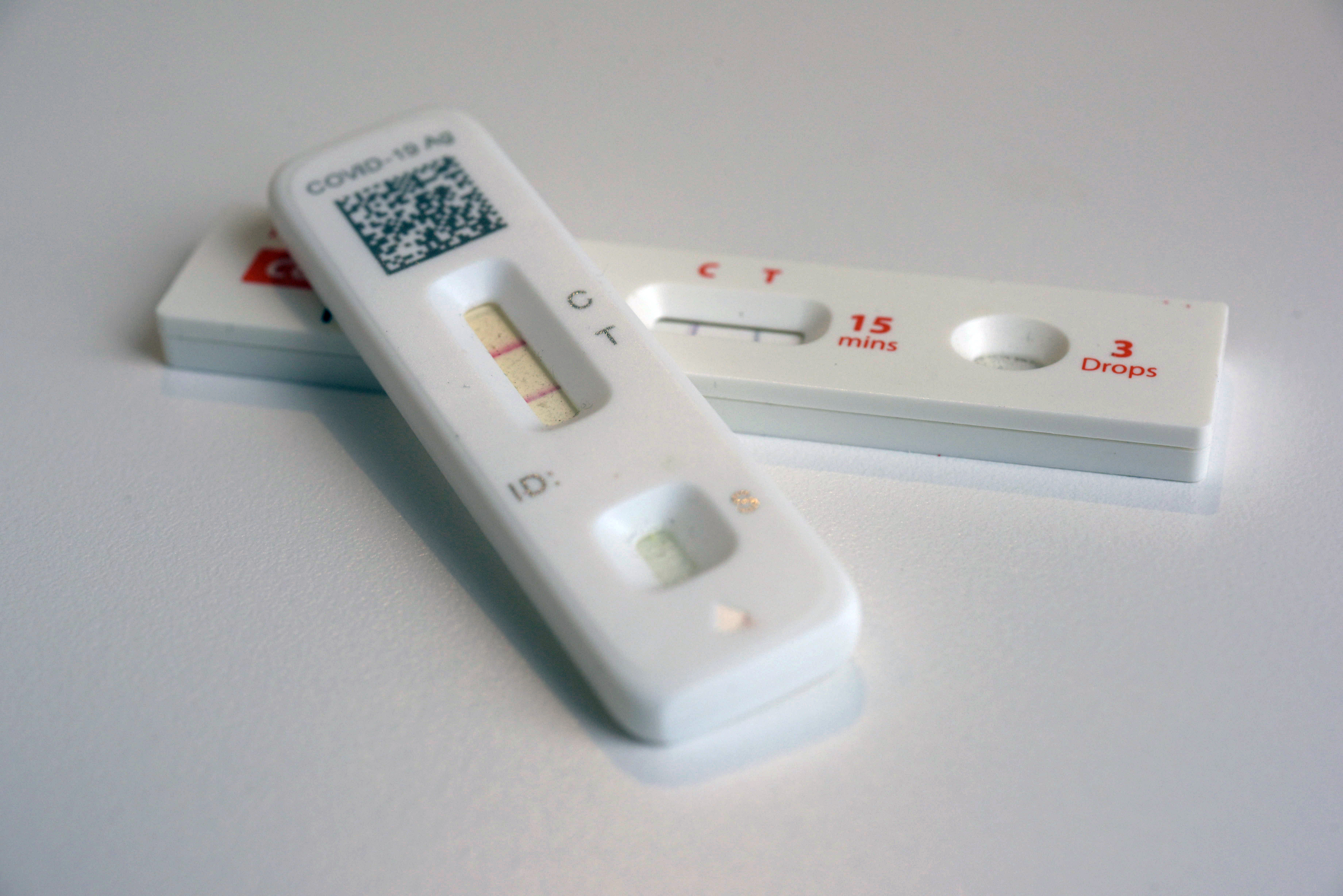When Portland resident Jessica Rogers-Hall came down with COVID last month – her third time – she followed the Oregon Health Authority’s advice.
She isolated when she truly felt sick. And after a day, when she began to feel better, she donned a mask and returned to her job as a life coach for people experiencing homelessness.
Others in her circle of friends and associates, including a restaurant worker and an airline pilot, who tested positive around the same time, also followed Oregon’s recommendations: Those with fevers or other debilitating symptoms stayed home for a couple days, but returned to work after that.
Rogers-Hall thinks Oregon is taking the right approach by telling the public their lives don’t have to come to a standstill when they catch the virus. Specifically, that it’s OK to go out with COVID as long as they’ve been fever-free for 24 hours and any symptoms they might have are improving. Officials just ask that those with the virus try to avoid immunocompromised people and wear a mask for 10 days.
“COVID is everywhere,” Rogers-Hall said. “Life goes on. It has to go on.”
Four years after the first cases of COVID arrived in Oregon and across the nation, public health officials are still grappling with how best to live with the virus. Last May, Oregon became the first to veer from the Centers for Disease Control and Prevention’s recommendation that anyone who tests positive for COVID stay home for at least five days and wear a mask for an additional five days.
But Oregon’s policy went unnoticed by many until last month, when California followed suit and a much more public national debate erupted among epidemiologists and regular folks alike. Many are pondering the question: Is COVID so mild for most that the public needn’t stay home when they still might be contagious? And further, should public health officials give their blessing for residents to return to their daily lives – to work, school, public transit, the gym, stores, social gatherings and the like?
This week, The Washington Post reported that the CDC may follow Oregon’s and California’s lead by revising its guidelines in coming months – possibly airing the idea for public feedback in April. The move would be what’s seen as a more practical approach toward what people are willing to do, in an era when COVID doesn’t pose a serious threat to most because of vaccinations or previous infections.
Dr. Melissa Sutton, OHA’s medical director for respiratory pathogens, said Oregon changed its guidelines nine months ago because it became clear the virus is pervasive, few people who have COVID actually test and asking that small portion of people to isolate was placing “a significant burden on the workforce and schoolchildren.”
Oregon has been one of the slowest to recover from pandemic learning loss.
“Isolation is a policy that is typically used when the public health goal is to contain an infection,” Sutton said. “That is not our goal.”
Sutton said the aspiration today is to “help people in Oregon make informed decisions to protect themselves from severe infection” – including advising people at higher risk to get tested if they have symptoms and take antiviral medication if they test positive.
In January, an average of about 250 people were hospitalized with COVID in Oregon on any given day, and the virus killed more than 60 people that month – a fraction compared to the height of the pandemic. But it’s still a formidable public health concern, especially for those at greatest risk of complications.
Sutton said in the nine months since the state lifted its five-day isolation guidelines, public health officials haven’t noticed a difference in hospitalizations and deaths in Oregon compared with other states. Sutton, however, said she doesn’t have data on whether the number who were only mildly or moderately sickened by the virus had increased compared to other states because states no longer track that information.
Oregon’s stance is news to many
Many Oregonians don’t appear to be aware of Oregon’s recommendations. The Oregonian/OregonLive queried three dozen people it randomly chanced across on Portland streets and and four out of five still thought they were supposed to isolate if they tested positive, regardless of their symptoms.
Those who told the news organization they knew of the state’s new stance said they learned through very specific channels: They worked in healthcare, their child’s school informed them, they work in education or they read an OHA newsletter outlining the policy. One person, who works at a bakery, said her employer informed her of Oregon’s recommendation – in hopes that Oregon’s new policy would help it combat a worker shortage by encouraging the staff not to call in so many sick days.
On the flip side, some of those interviewed told The Oregonian/OregonLive that staying home just because they tested positive would mean a loss in pay, but they had mixed feelings about going to work, especially in the food service industries. But a significant proportion also said they wouldn’t go out while knowingly having COVID.
Jen Grove-Heuser said when she, her husband and their 10-year-old daughter came down with COVID last fall, they isolated – her husband for two weeks. She said that wouldn’t have changed even if they had known the Oregon Health Authority advises the public they don’t have to.
Their daughter, who was the least sick of the three, only experienced symptoms for two days, and after that felt perfectly fine. But Grove-Heuser said she kept the girl home from school for an entire week – then sent her back wearing a mask – to break the chain of transmission.
Because otherwise, Grove-Heuser said, “that’s how it goes around. I think we can tamp it down if we all do a little to protect other people.”
But, she added, “I get the impression other people don’t feel that way.”
Grove-Heuser’s neighbor, Patricia Reilly, agreed with staying home. “It’s public health manners.”
Even Rogers-Hall, the life coach who tested positive for the virus last month, said although she thinks it’s fine to go out with COVID as long as people wear masks, she worries about high risk Oregonians. As soon as she found out she had the virus, she posted on social media to warn people in her downtown Portland condo building, as well as the one next to it, that she’d been in the elevators, the laundromat and the package room the previous day – so they might want to get tested if they come down with symptoms.
“It was more an act of kindness,” she said. “There are some older people who live here.”
Though Marna Gatlin lives miles away in the Bethany area of Washington County, she is one of those higher risk people because she’s immunocompromised. She said after being so careful for the past few years, including getting vaccinated, she finally came down with the virus last month a few days after visiting an outpatient surgical center where she was unsettled by people in the waiting room coughing and sneezing without masks on.
“I’m so mad at Oregon, I could throttle Oregon,” said Gatlin, who knew of Oregon’s updated recommendation. “You can walk around and be like Typhoid Mary – carry the virus and not manifest symptoms – and spread it around. It’s ‘Go to school, it’s OK. Go to work, it’s OK.’”
She said her medical condition made her ineligible for taking the antiviral medication Paxlovid.
“I only wish I was one of those people that felt this like a slight cold. I feel like I have been hit by a bus,” she said. “I have never been sick like this.”
She said she is still testing positive after five weeks – and congested, coughing and isolating, even if some medical experts say it’s unlikely she’s contagious after all of this time. She’s said she’s grateful her employer, the city of Portland, allows her to work from home.
“I’m not going anywhere,” Gatlin said. “I don’t want to give it to anyone.”
Public health experts weigh in
The Oregonian/OregonLive asked three experts – in Oregon, Washington and California – what they thought. All have backgrounds in public health, epidemiology or medicine. And all come from West Coast states that were among the most COVID-cautious in the nation during the pandemic.
Ali Mokdad, a University of Washington professor and epidemiologist, described Oregon as “courageous” for being the first to end its universal isolation recommendation for COVID. He said he would support the same in Washington and nationwide because he doesn’t think it does much good to ask only those who’ve gone the extra mile to test by confirming that they have the virus to stay home. It’s a tiny number, he said.
“For each of them, there are 20 people circulating in the office that have COVID and they don’t know it,” Mokdad said. “So why should we punish that guy?”
Dr. Esther Choo, an emergency medicine professor with a masters in public health at Oregon Health & Science University, isn’t enthusiastic about Oregon’s updated recommendations. She understands it may be a public-health compromise – telling fever-free people they can go out but to please wear a mask if they do.
A better approach, she said, would be to base whether it’s prudent to go out on testing: If you’re positive, stay home.
But she realizes that many people aren’t willing to fork over the money for home tests and deal with potential consequences.
“People don’t want to deal with the limitations that knowing about a COVID diagnosis imparts,” Choo said. “Because I think in some settings there’s still a social expectation that you don’t show up to the party with COVID. So it’s kind of like ‘Don’t ask, don’t tell.’”
Dr. Abraar Karan, an infectious disease expert at Stanford University, said he hopes the public takes heed of the newer guidance by wearing high-quality, well-fitted masks after testing positive. Even if people are fever-free for 24 hours, they still may be shedding virus.
And, Karan said, “just because your symptoms are improving doesn’t mean you’re no longer contagious. No way.”
Testing, isolating and wearing masks when sick are the best practices. But he said a recommendation is futile if most people aren’t following it. So Oregon’s and California’s policies could end up doing the most good, by at least encouraging people to mask whenever they have COVID-like symptoms, he said. Masks could protect others against diseases such as RSV and the flu, too.
“That should be the big takeaway,” Karan said, “that you can stop ongoing transmission even if you’re not isolating.”
— Aimee Green; [email protected]; @o_aimee
Our journalism needs your support. Please become a subscriber today at OregonLive.com/subscribe.

Rachel Carter is a health and wellness expert dedicated to helping readers lead healthier lives. With a background in nutrition, she offers evidence-based advice on fitness, nutrition, and mental well-being.








